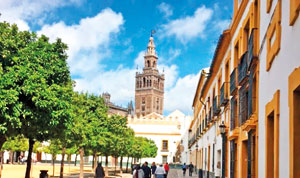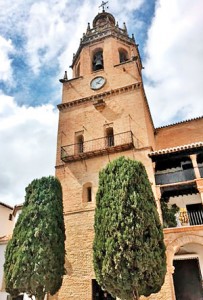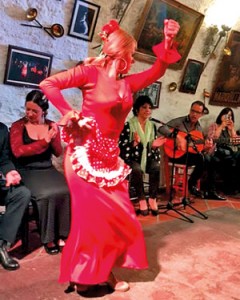Espana in all its glory

Alcazar, Seville
Southern Spain or ‘Al Andalus’ as it was called by the Moors, is a fascinating part of the country with many monuments showing its strong Moorish influence. The following are some experiences of a ten-day tour of Southern Spain that I undertook recently.
Our starting point was Madrid, a sprawling old city steeped in history, and filled with many historic plazas.The Plaza Mayor is Madrid’s main square and is located right in the centre of the city. The visit to the Palacio Real,located next to the Plaza de Oriente was very interesting. It is the largest Royal Palace in Europe and was built on the site of the Alcazar, the Moorish Castle destroyed by fire. The site had been occupied by Moors since the 10th century, who named the city’s river “AlMagrit,”meaning source of water, which later developed to “Magerit” and finally Madrid.
The palace itself contains furniture, tapestries, paintings and works of art, making it an important museum as well. We were able to admire the residence of former Spanish Kings and visited the Royal Chapel, Throne Room and the reception rooms of King Carlos and Queen Isabel II .
We stayed at the Hotel Emperador, which is on the Gran Via, the main street in Madrid which was also known as Jose Antonio Avenue until 1980. The hotel is close to the shopping district and all the main areas to be visited in Madrid. We visited the Prado Museum, set in a magnificent 17th century building, which had more than 1,000 paintings on display from the great Spanish Masters such as El Greco, Goya and Velazquez.

An old Mosque
Near the entrance to the Museum is the famous 16th Century Geronimo Cathedral, which is in a picturesque setting up on a hill. Even though the Museum was open till late in the evening, and entrance is free after 6 p.m., one cannot take in more than half a day of viewing of the great artists, such is the immensity of the collection.
We also visited the Real Madrid Stadium, which is a ‘must’ for lovers of football and a coffee in the cafeteria gave us a good view of the famous grounds.
We also visited the National Art Centre the Reina Sofia which was dedicated mainly to Spanish Art.The highlights of the Museum include two excellent collections of Spain’s two greatest 20th Century Masters, Pablo Picasso and Salvador Dali. The most famous was a mural sized oil painting on canvas by Picasso named “Guernica”, depicting the Spanish Civil War.
In the afternoon we took the fast AVE train from Atocha Station down to Seville, which was a smooth comfortable ride inclusive of a full meal service and ample space for luggage. When we reached Seville, we saw many people arriving at the station in traditional costume. It was the time of the annual Seville Fair called “Feria de Abril de Seville.” Each day the fiesta began with the parade of carriages and horse riders at midday, carrying Seville’s leading citizens. The fair grounds on the far bank of the Guadalquivir River was totally covered with rows of Casetas, which were individually decorated with red and white striped marquees belonging to prominent families of Seville, clubs and political parties. Inside the Casetas, we saw crowds enjoying tapas and dancing ‘Sevillanas’- the traditional dance form, in four parts. The final day culminated with a fireworks display at midnight. The Spanish people are friendly and readily agreed to pose for photographs in their colourful traditional costumes with members of the group.
We also took a city tour of Seville, visiting the Barrio de Santa Cruz with its narrow streets, the Park of Maria Luisa, Plaza de Spain and the Giralda Tower, which was in fact the place from where the Muezzin called the faithful to prayer. We also visited the Cathedral of Seville and the Alcazar .
In the afternoon, we drove to the picturesque white village of Ronda, where all the walls were painted with white limestone that reflected the heat. The drive is through miles of olive fields with ancient watch towers atop the hills and we stopped at a local shop that sold products made out of olive oil made in the region. They were very generous with the samples for tasting, which encouraged us to buy many of their local products including hand cream made of olive oil.
In the evening, the courageous members of the group witnessed a traditional bullfight, but returned to the hotel sooner than expected.
The next day, we drove for about two hours to Cordoba and visited the Great Mosque of Cordoba, often referred to as “La Mezquita.” Following the Islamic Invasion of Cordoba, the Muslims began the construction of the Mosque, that became the sanctuary of Western Islam, when Cordoba was the capital of Al Andalus. It is one of the largest mosques in the world, and underwent four stages of construction under various leaders. It was later transformed into a Cathedral after the Christian invasion in the 11th Century.
It was interesting to see the remnants of the old Mosque and the transformation into a Cathedral with many parts of the original structure with the overlapping arches of the alternating red brick and beige lime stone work still in intact. The orange tree courtyard was one of the remnants of the Muslim period.
The following day, after a two-hour drive we arrived in Grenada and visited the impressive monuments of the Alhambra and its beautiful Nazari Palace and the “Genaralife,” derived from “Jennathul Ariff”, meaning gardens of Paradise. The historic name of the Alhambra, derives from the Arabic “alqalaal hamra” or red castle, referring to the red walls.

A gypsy flamenco dancer
The fortress at the foot of the Sierra Nevada mountains was strengthened by the founder of the Nasri Dynasty, Muhammed ibn Nasr in the 13th century. We entered through the Impressive Justice Gate, a horse shoe shaped arch into the Mexuar Court . We passed through the elaborate King’s Chamber and entered the Hall of Ambassadors which was the audience chamber of the Muslim monarchs.The Sal del Reposo had an impressive array of old mosaic tiles and the walls were embellished with alabaster carved with Quranic verses in the Kufic script. The lofty ceilings were supported by slender columns that still bear traces of their vivid blue colour. The heavy cedar wood doors carved in geometric designs opened into the Courtyard of Lions, a basin fountain held up by sculptured lions.
The well laid out gardens were an engineering marvel with all the beautiful fountains being served by underground aqueducts constructed in the Moorish period. From strategic viewing points, one saw the verdant Darro Valley below.
Granada survived for over 250 years, as a Muslim enclave in Christian Spain, with Alhambra as its symbolic heart. The visit to the Alhambra Palace and the Gardens involved a lot of walking and climbing up and down stairs, so be well prepared for it. In the evening, we drove through the narrow winding streets of the Albaicin Quarter, which retained much of its medieval Moorish past.
We watched with interest a typical Gypsy flamenco dance performance in the Sacramento Caves. On the drive back we saw the beautiful Alhambra Palace floodlit, silhouetted against the night sky on the opposite hill.
We took the long drive back to Madrid through the rolling countryside and saw the snow capped Sierra Nevada Mountains in the distance. We took a stop at the Imperial city of Toledo, steeped in history and went sightseeing through its narrow alleys and cobbled streets. The pedestrian climb upto the city, located on a hill was through a series of escalators.This old city being considered a National Monument had been declared a World Heritage City by UNESCO.
In the evening, we attend another Flamenco Show, at the Cafe de Chinthas, the Cathedral of the Flamenco, located in the old quarter of Madrid in a 17th century palace, near the Plaza of Spain. This show was in a Bar cum restaurant serving the traditional Tapas and Sangrias, while the Flamenco was performed on a stage with both male and female dances using the castanets and accompanied by acappella singing.
On our last day, we took a drive down to the Monastery of El Escorial and Valley of the Fallen, and passed through the beautiful countryside and the snow capped Sierra de Guadarrama mountains. During the reign of King Philip II it was built as a residence for the Spanish kings and monastery. We also visited the San Lorenzo de El Escorial, which iss a large wooden cross atop a hill and visible from a great distance all around.In the afternoon , we visited the Thyssen Bornemisza museum, which houses the largest collection of artwork from the 13th to the 20th Century. The Collection featured art from Renaissance, Baroque, Romantics and so many celebrated artists such as Van dyck, Rubens and O’Keefe.
All in all, it was a very enjoyable trip. Viva Espana !


